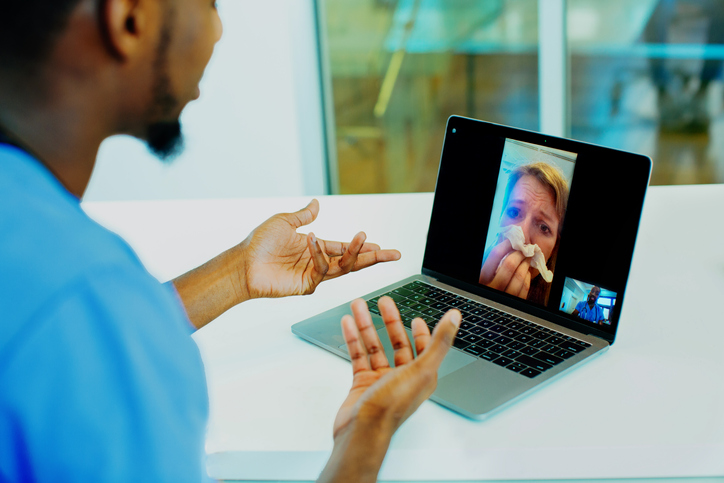
With most patients are confined to their homes, it’s no surprise that telehealth providers are seeing a surge in visits. But as they onboard more providers to handle increased demand, will patients continue to use their services in the long run?
At this point, volumes have increased well beyond peak flu season numbers, said Charles Jones, CEO of MDLive, a large telehealth provider that recently struck a partnership with Cigna. Typically, the company sees about 4,000 visits per day during flu season. With the pandemic, MDLive began to see 7,500 visits per day, and as many as 20,000 new patient registrations daily.

With the Rise of AI, What IP Disputes in Healthcare Are Likely to Emerge?
Munck Wilson Mandala Partner Greg Howison shared his perspective on some of the legal ramifications around AI, IP, connected devices and the data they generate, in response to emailed questions.
Most of the visits were for day-to-day healthcare needs, such as high blood pressure or a cold. Jones said MDLive also saw a big increase in demand for behavioral health services, with many anxious over their health or their jobs.
“Our business is seasonal. Our heavy season is flu season,” Jones said. “At the end of the flu season, the pandemic arrived. It wasn’t initially a whole lot of calls concerning the coronavirus. It was people who have normal healthcare needs who now decided they’d rather do it by video.”
Others saw a similar increase:
- Teladoc, another telehealth provider, reported a spike of visits in the early stages of the pandemic. The week of March 13, it saw visits jump 50% over the prior week, with as many as 15,000 visits requested per day.
- As of Tuesday, AmWell said its patient visit volume was up 250 percent compared to the number of visits the company would normally see this time of year. In some states, the numbers were higher, with cases up 427% in Washington state and up 600% in New York, the company wrote in an email.
- Livongo, which makes remote patient monitoring solutions for patients with chronic conditions, raised its revenue guidance for the first quarter from $60 million to $62 million to $65.6 million to $66.5 million. The company said it had a record number of client launches, 620, in the first quarter.
In a panel with the American Telemedicine Association, Livongo President Jennifer Schneider said the company had received significant interest from health systems and employers.
“We have a ton more inbound requests, because our remote monitoring is particularly for this vulnerable population,” she said.
The company’s CMO, Dr. Bimal Shah, said he expects to see demand for remote monitoring continue to increase in the future.
“We know that as providers adopt telehealth and remote monitoring during this pandemic, they have quickly adjusted their workflows, adoption and acceptance of these platforms,” he wrote in an email. “In fact, many of my colleagues are enjoying the convenience of these interactions and our members are deriving value from the convenience of easily being able to share their data with their doctors without having to leave the comfort of their home.”
Because Livongo’s platform routes users to digital tools before its coaching services, Shah said its platform should scale easily.
With MDLive, Jones said the platform had also been built to scale, so its systems were able to keep up with the growing number of patients. The company bolstered the number of available doctors on its platform by 40%.
“Mercifully, our technology systems, our platform, remained in place without interruption,” he said. “We had been developing a pipeline of potentially interested doctors before.”
Preparing for future demand
If demand for visits continues to grow at this pace, Jones said MDLive might tweak its business. Just as a nurse is the first person to see patients in many primary care practices, MDLive might bring in nurses or nurse practitioners for virtual care.
“That might become part of our protocol,” he said.
He also expects to see more remote diagnostic monitors come into use.
Jones expects to see the number of visits continue to grow in the future, but is watching to see if policy changes made in response to Covid-19 will stick. As a result of the pandemic, private health insurance companies changed their plans to make it easier for physicians to get reimbursed for telehealth. At the federal level, the Centers for Medicare and Medicaid Services also lifted several barriers to telehealth access, including reimbursing for in-home telehealth appointments.
The state level, on the other hand, is a different picture. Only eight states have removed licensing requirement that would allow physicians to practice in multiple jurisdictions.
“I think there’s been a lot of local resistance to that. It’s unfortunate that more hasn’t changed,” he said. “As a consequence, I suspect those regulations are less likely to change afterwards.”
It’s not yet clear whether telehealth coverage will go back to business-as-usual once the pandemic is over, or even when it will end, Jones said.
“Frighteningly, yesterday a credible prediction saw that we’re going to see a second wave (of Covid-19) in the fall. Early on, like many, I thought by summertime this is over,” he said. “That may institutionalize some of the experiences we’re having now.”
Photo: CarlosDavid.org, Getty Images
This article has been updated with comments from Livongo CMO Bimal Shah














